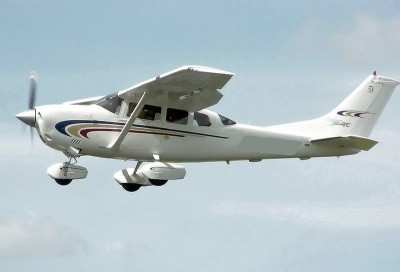Fri, Aug 08, 2014
ATSB Credits Training With Avoiding A Possible Fatality
The quick actions of pilot of a Cessna 206 in Australia prevented the aircraft from catching fire when it went down in a field after developing engine problems shortly after takeoff.

According to the ATSB's final report on the accident, which occurred on February 24, the Cessna departed runway 05 at Newman Airport, Western Australia, at about 0526 Western Standard Time for a charter flight to Cotton Creek in visual meteorological conditions. The pilot was the only occupant.
About 3 minutes after take-off, while in the climb and at about 1,500 feet above ground level the pilot conducted a scan of the aircraft instruments and noticed that the engine oil pressure gauge was indicating zero. All the other engine instrument indications were in the normal range.
The pilot turned the aircraft back towards Newman airport. About 1 minute later the pilot observed sparks coming from the engine cowling near the propeller, the engine power decreased and a severe vibration was felt through the airframe. The pilot pulled the mixture control to lean cut off to stop fuel flowing to the engine as he was concerned about an inflight fire and the propeller stopped rotating.
The pilot determined that he would not be able to glide to runway 23 and began a scan to locate a suitable landing area. The pilot located a paddock that was about 4 km (2.5 miles) from the airport that appeared to be a suitable landing area and was near a dirt road. Prior to landing, the pilot shut down all non-essential aircraft systems.
On landing, the left wing impacted a tree and the aircraft spun around 180 degrees. The pilot shut down all remaining systems and climbed into the rear section of the aircraft. The pilot exited the aircraft through the rear section of the cargo door and was not injured. The aircraft was substantially damaged.
The ATSB says in its report that this accident “highlights the importance of pre-flight decision making and planning for emergencies and abnormal situations for the particular aerodrome including a thorough pre-flight self-brief covering the different emergency scenarios, conducting a thorough pre-flight and engine ground run to identify any issues that may lead to an engine failure and taking positive action and maintaining aircraft control either when turning back to the aerodrome or conducting a forced landing until on the ground, while being aware of flare energy and aircraft stall speeds.”
(Cessna 206 pictured in file photo. Not accident airplane)
More News
Light Gun A handheld directional light signaling device which emits a brilliant narrow beam of white, green, or red light as selected by the tower controller. The color and type of>[...]
"The journey to this achievement started nearly a decade ago when a freshly commissioned Gentry, driven by a fascination with new technologies and a desire to contribute significan>[...]
Aero Linx: JAARS, Inc. For decades now, we’ve landed planes on narrow rivers and towering mountains. We’ve outfitted boats and vehicles to reach villages that rarely se>[...]
"Our driven and innovative team of military and civilian Airmen delivers combat power daily, ensuring our nation is ready today and tomorrow." Source: General Duke Richardson, AFMC>[...]
Aircraft Conflict Predicted conflict, within EDST of two aircraft, or between aircraft and airspace. A Red alert is used for conflicts when the predicted minimum separation is 5 na>[...]
 ANN's Daily Aero-Term (04.20.24): Light Gun
ANN's Daily Aero-Term (04.20.24): Light Gun Aero-News: Quote of the Day (04.20.24)
Aero-News: Quote of the Day (04.20.24) ANN's Daily Aero-Linx (04.21.24)
ANN's Daily Aero-Linx (04.21.24) Aero-News: Quote of the Day (04.21.24)
Aero-News: Quote of the Day (04.21.24) ANN's Daily Aero-Term (04.21.24): Aircraft Conflict
ANN's Daily Aero-Term (04.21.24): Aircraft Conflict



